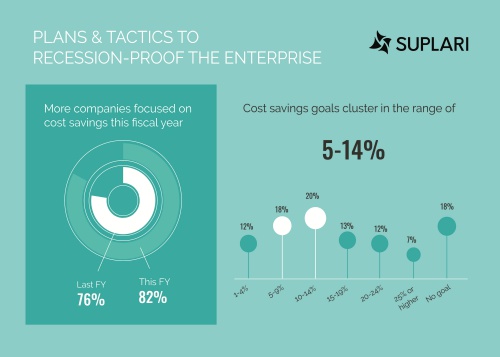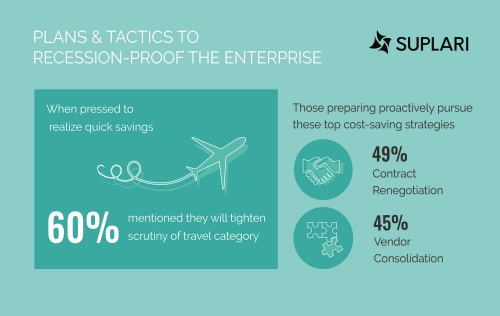While many fundamentals suggest the U.S. economy remains healthy, there are also looming signs of a slow-down. If a recession takes place, procurement and finance professionals are likely to be the first in their organizations to perceive and deal with the impact. Suplari has conducted the study "Plans & Tactics to Recession-Proof the Enterprise: A Survey of Procurement & Finance Professionals" to give practical and proactive insights about their peers’ concerns, preparedness and coping tactics for an eventual recession or economic downturn. We've also designed part of the survey's questions to assess if a recession could impose on procurement teams to become overly focused on short term and tactical cost-savings goals.
Is a recession on the horizon and are companies preparing for it?
Procurement and finance professionals are predicting a recession on the horizon. A majority (55%) of respondents believe a recession will take place within 18 months, before the end of 2020. Interestingly, the percentage is even higher (70%) when considering only the responses from executives in C-suite or VP roles. With regard to proactive preparation, an encouraging 61% of respondents demonstrated confidence in their companies’ preparedness. However, there remains an alarming 30% that feel unprepared or unaware of their organization’s ability to cope with an upcoming recession. The remaining 9%, although also feeling without preparation, simply don't foresee a recession on the horizon.


When asked about their top concerns if a recession were to occur, respondents were most likely to cite impacts that directly affect their departments, in the form of budget cuts and headcount layoffs. The next big concern is that their procurement and financial teams will be pressed by the C-suite demanding to quickly find cost savings. As a matter of fact, more companies are already focusing on cost savings this fiscal year, with 8 in 10 companies having established savings goals. Among the companies that do have savings goals, the majority aim for 5% to 14% in savings.
Delivering Needed Cost Savings while remaining well-rounded across tactical and strategic impact
- When asked about what typically happens to cost-savings found by procurement, 61% said that savings go straight to the bottom line. Still, an even larger number (67%) claimed the funds will be reinvested in long-term projects. And those two destinations are not even mutually exclusive, as 37% of respondents actually mentioned both.
- Next, in the list of top concerns, respondents pointed out aspects related to those service and quality levels in Dawn's article. They pointed out the risks of supplier business continuity and solvency, and the related preparations to assess vendors and possible new suppliers, if or when needed.
- The report also showed alignment in the answers across procurement and finance. Finance is usually perceived as strategically focused on the enterprise financial health, measured on the basis of not only savings, but also cash flow, margins, working capital and ROI of business initiatives. Procurement leaders share those imperatives.

When asked about categories that could get tightened in case of economic need, respondents ranked travel as the most scrutinized category. Listed next were facilities expenditures as well as office equipment and services, which did not surprise me. Companies have large amounts of dollars flowing through travel and expenses (T&E). Left unchecked, T&E programs can invite managerial concerns, and even actual cases of fraud or non-compliance.








